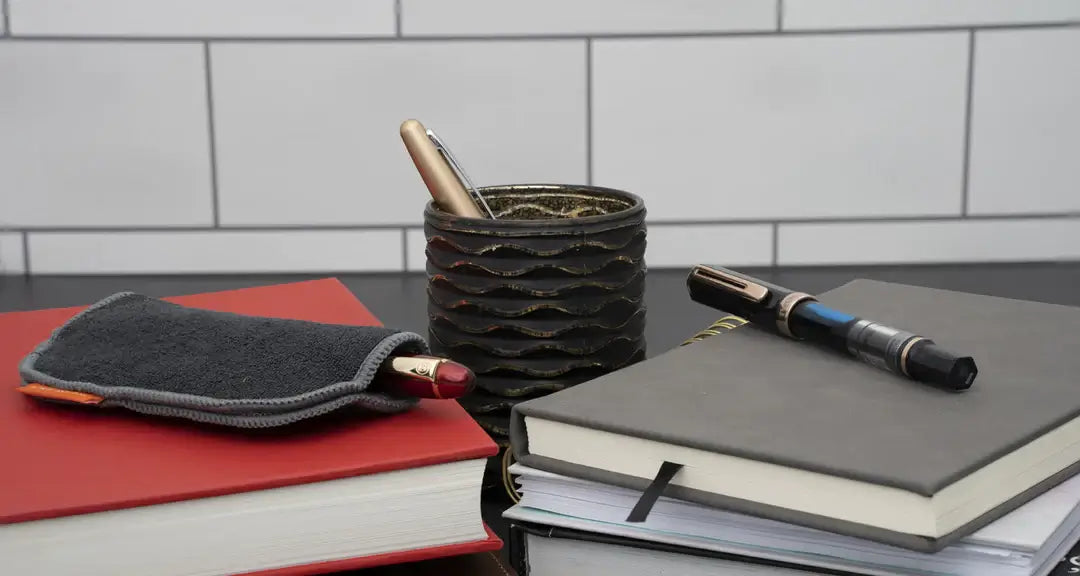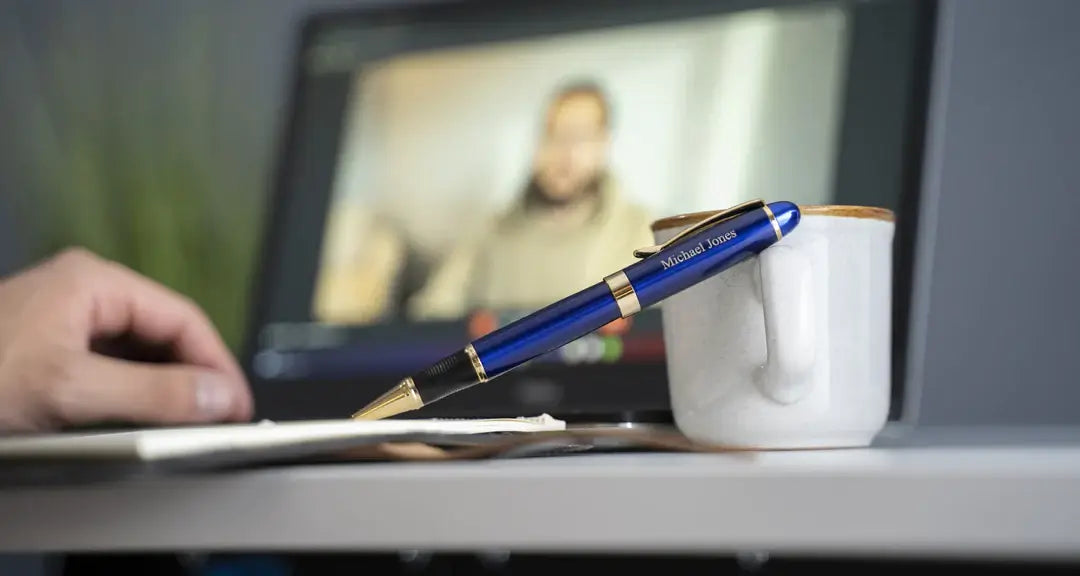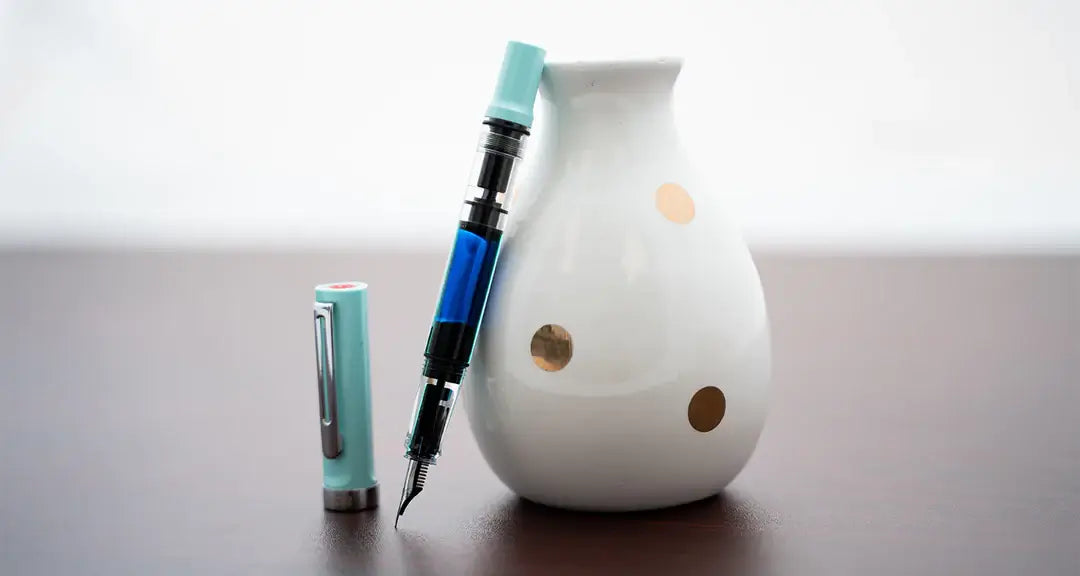Take just one look at a fountain pen and you will wonder about how this oddly shaped writing instrument works.
Compared to the common ballpoint pen, the fountain pen looks like something out of an antique store and even those who have been using them for years might not really know how these pens actually get the ink onto the paper.
However, in this article, we are going to tackle it all. How fountain pens work, what makes up a fountain pen, and just what you need to know to get the most out of writing with a fountain pen.
Let's start with the big question.
How does a fountain pen work?
Fountain pens work by using gravity and capillary action to draw liquid ink from a reservoir inside the pen down through a feeder to the metal writing point of the pen called a nib.
It sounds relatively simple that gravity essentially pulls ink out of the pen, but the history of the working of the fountain pen has been a long one of trial and error. For a thousand years people attempted and failed to make a functional fountain pen.
It wasn't until the end of the 19th century that the modern fountain pen came to be a usable pen for constant, daily writing.
Each part of the fountain pen took years of development and ingenuity to make a complex, well designed writing tool.
So what exactly is a fountain pen?
What is a fountain pen?
A fountain pen is any pen that holds ink in a reservoir and writes with a metal nib.
It is the combination of the two elements that makes a fountain pen.
A ballpoint, for instance, holds ink inside a reservoir (the ink refill), but it lacks the metal nib.
On the other hand, most calligraphy pens have a metal nib but are technically dip pens, like old fashion quill pens, since they require the user to constantly dip the pen in an ink bottle to write.
The Anatomy of a Fountain Pen
The nib, the feeder, the section, the ink reservoir, the body, and the cap make up the anatomy of a fountain pen. However, all these parts of the fountain pen must work together to ensure smooth writing.
The Nib
The fountain pen's nib is the metal point where the ink meets the paper.
The nib is a single piece of metal that tapers down to a point. At the center of the point is a slit to the middle of the body to create two flexible tines with a small hole (called a breather hole) where the slit ends.
TRY A PILOT NIB TODAY
The slit acts as a channel for ink to run down to a reinforced tip and also give the fountain pen an adaptive element.
Fountain pens release more ink on downstrokes when you apply more pressure, causing a tell-tale change in the thickness of the writing line. This is because the slits move and flex with the pressure or position of writing.
The Feeder
The feeder or feed of the fountain pen is a plastic (or ebonite/celluloid in vintage pens) component that attaches the nib to the ink supply.
The fountain pen feed serves a twofold purpose.
Firstly, it controls the flow of the ink by giving the ink a place to move along.
Second, it allows air to simultaneously flow back up into the ink reservoir for a continuous flow of ink.
We will go more in depth into why this matters when we talk about how ink flows through fountain pens.
The Section
The section of the fountain pen holds the nib to the feeder and then attaches those to pieces to the ink reservoir.
It can also be called the grip since the outer shell of the section is where the fingers will hold the pen.
Sections contain the threads that twist the barrel and the entire nib housing together.
The Ink Reservoir
The ink reservoir holds the fountain pen ink.
You can use a single-use ink cartridge as the reservoir and change it when the ink runs out. On the other hand, you can use an ink convertor which lets you refill ink reservoirs with bottled ink.
There are many different types of ink converters, and you will find a list of the different kinds further on in the article.
The Body
The body of the pen, also called the pen barrel, houses the ink reservoir.
The Cap
The cap covers the writing point of the fountain pen and often has a clip.
How does the ink flow through a fountain pen?
Ink flows through a fountain pen through a combination of gravity and capillary action. Gravity draws the ink out of the reservoir to the writing nib and capillary action controls the flow so ink does not flood out of the pen.
What does that actually mean?
Let's take a closer look at those two processes and how they affect fountain pens.
Gravity
Every pen from the ballpoint pen to the fountain pen works because of gravity. However, there are exceptions for specialized ballpoints made to write upside down.)
Whatever direction the pen is held, the ink will flow.
So easily enough by putting the nib of the pen point down ink will begin to flow out of the pen.
And the predecessor to the fountain pen, the reservoir pen, was based entirely on gravity.
But there was a major drawback with a gravity fed liquid ink pen: the inconsistency.
Gravity pulled the ink out of the pen until there was no ink. Pens would constantly leak or ink would flood out because there was no way to keep the excess ink inside the pen.
There was no way to control the flow of ink out of the pen. Pen technology suffered for hundreds of years until the discovery of capillary action.
Capillary Action
The process of capillary action draws liquid into a narrow space through cohesion to the liquid and adhesion to a solid, with little to no impact from the force of gravity.
Think about sticking a straw in a drink. Within the straw a certain amount of liquid moves above the water line in your glass. This is capillary action.
Liquid molecules like to stay together and this is called cohesion. But liquid molecules also stick to solids through a process called adhesion. In a narrow space, liquid will adhere to the walls of the solid, drawing more liquid molecules with it through cohesion.
So what does this mean for the working of the fountain pen?
A piece of plastic with a slit down the center, a flat surface on one side, and thin fins on the other makes up the fountain ped feed.
These fins act as channels by which the liquid can adhere and hold excess liquid.
How capillary action and gravity work together
On one hand gravity causes the ink to fill the feed, while on the other, capillary action draws the ink into these channels, adhering the ink to the fins and cohering the liquid to itself.
Then once the tip of the pen touches a writing surface, capillary action begins again, drawing the liquid out of the channels through cohesion as the liquid adheres to the paper.
So, gravity causes the pen to "leak" and capillary action controls the leak in order to write.
Airflow and the modern fountain pen
There is one last element to modern fountain pens that is pivotal to a good working pen, and it has to do with airflow.
As much as gravity and capillary action make fountain pens work, air flow is also critical to releasing the liquid ink from the reservoir steadily,
When a chamber such as an ink cartridge is filled with liquid and a small hole is punctured into the cartridge...nothing will happen.
This is because air will act like a seal against the hole. Air needs a place to go.
However, in order for liquid to properly flow and the fountain pen to work, the air around the liquid must be able to flow. As a result, you see small air holes in your reusable water bottles. Without a way to let air in to fill the space created by liquid leaving a chamber, the space in the chamber will become pressurized.
What is remarkable about the modern fountain pen feeder is that the fins that create capillary action, also allow air to flow back up into the reservoir creating a steady, constant liquid flow.
The internal filling mechanism of a fountain pen
Now let's talk a little bit about the reservoirs that hold the ink.
As I mentioned in the Ink Reservoir section of the Anatomy of the Fountain Pen, there are two major types of ink reservoir by which the modern fountain pen operates: the disposable cartridge and the refillable converter.
Disposable cartridges are single use plastic tubes of the proprietary sizing for a fountain pen brand. When the cartridge runs out of ink, the entire tube is replaced.
Refillable converters will also be proprietary to the brand of fountain pen, but offer far more versatility both in the type of ink used and in the type of self-filling mechanism.
For converters, the entire nib is submerged into an ink bottle, the mechanism is engaged, and the reservoir is filled with ink.
Shop Now: Fountain Pen Ink Refills
Piston Converter
A piston converter is the most common of the ink converters. It works by drawing the ink into the reservoir as the knob is twisted to move the piston up or down and bring ink into the housing.
EXPERIENCE A PISTON CONVERTER
Squeeze Converter
A squeeze converter (much like a bladder/ink sac converter) is the simplest of the converters. Squeeze the sac to expel air and release to draw the ink into the reservoir.
USE A SQUEEZE CONVERTER
Push Button Converter
The push button converter is the least common of the three converters. After inserting the nib into the bottled ink, push the button until the ink is drawn in.
Related Reading: Types of Fountain Pens
So what is so special about fountain pen ink?
What is fountain pen ink made of?
Fountain pen ink is composed of dyes, water, and additives that tailor the ink for desired traits.
Fountain pen ink is incredibly customizable in the fact that you can find many different kinds of fountain pen ink from along the color spectrum, any variety of thickness, sheens, sparkles, archive quality, water-proof, etc.
It is the water-based (or liquid-based) ink that sets the fountain pens apart from ballpoint pens or gel pens which use oil or gel bases.
The upside of fountain pen ink is that it is incredibly smooth offering wet lines and a fluid writing experience.
The downside is that it is susceptible to drying out if the pen is left uncapped.
What is so special about fountain pens?
Fountain pens are special because they have a unique writing experience and a smooth writing line that cannot be found in any other writing device.
Not only is there an exceptional amount of freedom in choosing the type of ink, fountain pens offer the ability to alter a writing line with different nibs or even just by changing the pressure or position of a pen.
"I love fountain pens. I have a collection and I use every single one." -Jacqueline Winspear
Types of fountain pen nibs
Partly due to the flexibility of the metal and partly due to how much ink a writer would like put down onto the page, there are quite a few different kinds of nibs to choose from.
Pointed Nib
Pointed nibs come to a sharp point and are incredibly flexible. They are the most adaptive to handwriting and the most affected by writing pressure.
More pressure on the writing point causes the pen's tines to separate more and release more ink for a thicker line.
Pointed nibs are often used for technical drawing or sketching when precision is vital.
Broad/Italic Nib
Broad nibs are characterized by a more rigid metal and a flat writing edge.
Instead of applying various pressures while writing, the broad nib is dependent on the angle of writing. A stroke will be thinner or thicker by the angle of the pen to the page.
Broad nibs are most commonly used in calligraphy or italicized writing.
Stub/Conventional Nib
Conventional nibs are the most common nibs and what you will probably see on most modern fountain pens. I put conventional and stub together because both have rounded edges.
A blend between the pointed nib and the broad nib, the stub nib narrows to a point, but is tipped with a rounded point.
The size of the rounded point will determine the fineness of the writing and distinguishes between a conventional and a stub with point size varying from extra fine 0.5mm (conventional) to 1.9mm (stub) on average.
These nibs tend to have a medium flexibility and are most common for everyday writing.
In the table below, I've highlighted the differences between various styles of fountain pen nibs:
Nib Style
Characteristics
Common Sizes
Round Nib
Standard, versatile
Fine, medium, broad
Italic Nib
Cursive writing, calligraphy
1.1mm, 1.5mm, 2.0mm
Flex Nib
Line variation with pressure
Extra-fine to broad
What is the difference between a fountain pen and a ballpoint pen?
There are two major differences between a fountain and a ballpoint pen:
The writing mechanism
The type of ink used in the pen.
Fountain pens have a metal nib writing point where gravity feeds ink from the reservoir through the feeder down to the nib tip of the pen. Ballpoint pens use a ball and socket mechanism that coats the ball at the tip of the pen in ink as it spins to create a writing line.
Ballpoint ink also differs significantly as it has an oil-based composition with high viscosity, and it dries almost instantly when you write(the ink binds to the paper's surface).
Fountain pen ink is water-based allowing for a smoother, flowing writing line that has low viscosity. The ink requires a few seconds of drying time as it needs to soak into the fibers of the paper.
Ballpoint pens and fountain pens both serve very different writing purposes. Ballpoints are best on low quality paper and writing in a variety of circumstances. Fountain pens are ideal for dedicated writing, drawing, or signing documents.
How do you use a fountain pen for beginners?
As a beginner start with an affordable, easy-to-use fountain pen, always writing with the pen at a 45ish degree angle.
Fountain Pens for Beginners
The ideal beginner fountain pen is comfortable, simple to use, and is cheap.
My personal favorite for getting a feel for using a fountain pen is the Pilot Metropolitan Fountain Pen. For under $20, you get a pen that is highly used and coveted by new users and collectors alike.
EXPERIENCE A METROPOLITAN
Honorable mention to the TWSBI Eco, my daily user. Easily, the next step up if you enjoy the Metropolitan and want to try a different brand of fountain pen. It's also great if you have a second pen to fill with a different kind of ink.
How to Write with a Fountain Pen
To write with a fountain pen, remember to keep it at a 45ish degree angle.
Nibs are not built to withstand the direct downward pressure used on a ballpoint or rollerball pen. Best case scenario you will bend your nib; worst case it will snap.
The angle allows the tines to flex properly and gives your fountain pen the tell-tale variations in line width. Additionally, it allows for a proper flow of ink.
Tips for using fountain pens
Do not apply a lot of pressure. Fountain pens don't require pressure to write and too much will bend your nib
Paper matters. The higher the quality of paper, the more function you will get out of your fountain pens
Find the sweet spot. Make sure you are not writing on a single one of the two tines. You want your fountain pen to be at an angle with both tines touching the paper
Connect your writing: cursive writing exists to diminish the amount of pick up and put down a pen requires. With liquid ink, connected writing will result in less pooling (a lot of ink in one spot).
Clean your fountain pen between ink refills: fountain pen ink will dry out over time. It is always good to rinse the feed/nib housing between refills.
Store up: How you store your pen matters. If you aren't going to use it for a while, store it with the point up. If you are using it steadily through the day, store it flat. Never store it point down; gravity will eventually drain the ink into your cap.
Always cap your pen: fountain pens have liquid ink and will dry out. When not in use, put the cap on so your pen is ready to write when you need it next.
Conclusion
Fountain pens aren't the simplest of pens, but they can be the most satisfying and creative to use.
Harnessing gravity, air flow, and capillary action, the liquid ink fountain pen offers a completely unique writing experience, customizable to you.
What is your favorite thing about how fountain pens work?
Leave a comment below!
Sam Di Nardo is an author for Dayspring Pens, where she has honed her expertise in ballpoint, rollerball, gel and fountain pens since joining the team in 2018.
From her initial role as an Engraver to becoming the Production Manager, Sam's journey has been marked by her passion for the history, manufacturing, and the unique value of gifted writing instruments.
A graduate of Regent University with a degree in English Literature and a special interest in Old Norse literature, dive deeper into Sam's world and discover why she's your trusted guide in the realm of gift pens.
Follow Sam on LinkedIn.











